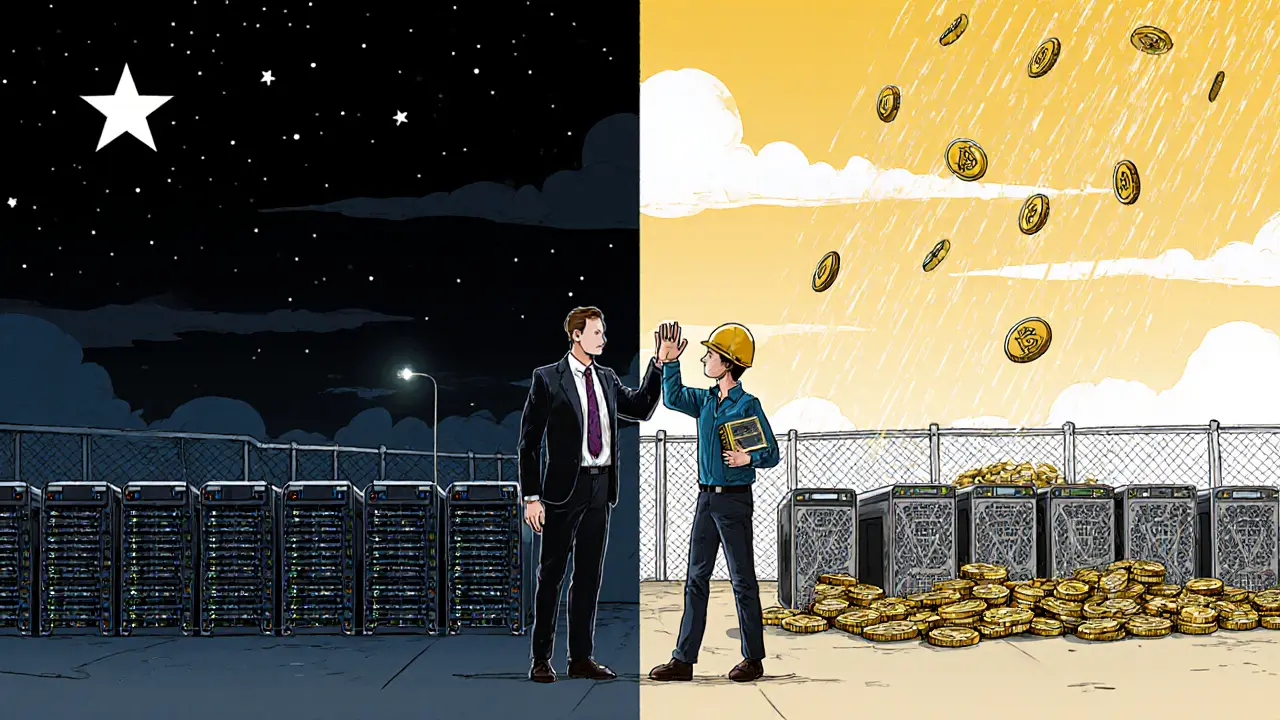Bitcoin Mining Profitability Calculator
Calculate Your Bitcoin Mining Earnings
Compare solo mining vs pool mining based on your hash rate and electricity costs
Input Your Mining Details
When you start mining Bitcoin, the first big decision isn’t which ASIC to buy-it’s whether to mine alone or join a group. Solo mining sounds appealing: you find a block, you keep the full reward. No middleman. No fees. Just you and the blockchain. But in 2025, that dream is harder than ever to turn into reality. Meanwhile, pool mining offers steady payouts, simple setup, and near-guaranteed income-if you’re okay with sharing the reward. So which one actually makes sense for you?
What Solo Mining Really Means Today
Solo mining is when you run your own mining hardware and connect directly to the Bitcoin network. You’re not sharing your hash power with anyone. If you solve the cryptographic puzzle and find the next block, you get the entire 3.125 BTC reward plus all the transaction fees. That’s it. No splits. No deductions. But here’s the catch: the odds are stacked against you. As of late 2025, the Bitcoin network’s total hash rate sits at over 750 EH/s. That’s 750 million terahashes per second. To have even a 50% chance of finding a block in a year, you’d need around 0.6 EH/s-600 PH/s-of your own hash power. That’s not a single ASIC. That’s roughly 1,800 Antminer S21 units, each pulling 336 TH/s. And that’s before you factor in electricity, cooling, or maintenance. Most individual miners operate with 10 to 100 TH/s. At that level, statistically, you’d wait over five years to find a single block. One miner on Reddit ran 200 TH/s for 14 months and found nothing. Another with 2.5 EH/s found three blocks in six months. The difference? Scale. Solo mining isn’t a hobby anymore-it’s a corporate operation. You also need a full Bitcoin node running 24/7. That means reliable internet, stable power, and technical know-how. Configuring bitcoin.conf, syncing the blockchain, managing ports, and monitoring uptime isn’t beginner-friendly. GoMining’s 2023 study found solo miners spend 40-60 hours just learning the setup. Most give up before they even start mining.How Pool Mining Works (And Why It’s Dominant)
Pool mining is the opposite: you team up with hundreds or thousands of other miners. Your hardware connects to a mining pool server via Stratum protocol. You contribute your hash power, and the pool combines everyone’s efforts to find blocks faster. When a block is found, the reward is distributed based on how much work each miner contributed-usually measured in “shares.” Pools charge a fee-typically between 0.5% and 3%. Slush Pool charges 2%. F2Pool uses a PPLNS model (Pay Per Last N Shares), which averages around 1.5% in practice. That’s it. No hidden charges. No surprise fees. The result? Consistent payouts. A miner with 100 TH/s might wait five years to find a block solo. In a pool, they earn about $12.50 per day after fees. That’s $4,500 a year. Enough to cover electricity in many regions. You don’t need to be rich to start. You can begin with a single Antminer T19 (95 TH/s) or even a used ASIC. Setup is simple. Most pools-like F2Pool, Slush Pool, or ViaBTC-offer web dashboards. You enter your wallet address, copy a few lines of config, plug in your miner, and you’re mining in under 15 minutes. No node setup. No technical headaches.Who Should Mine Solo?
The only people who should consider solo mining are those with massive resources. Foundry USA, for example, controls 13.5% of Bitcoin’s total hash rate. They mine solo because they can afford to. Their infrastructure costs millions, but their reward frequency justifies it. Same with Marathon Digital, Riot Platforms, and other publicly traded mining firms. These are not individuals. They’re corporations with legal teams, data centers, and power contracts. If you have over 1 EH/s (1,000 PH/s), solo mining might make sense. You’ll find blocks every few weeks or months. Your cash flow becomes predictable. You avoid pool fees entirely. And you contribute directly to Bitcoin’s decentralization-something many purists value. But if you’re reading this because you just bought your first ASIC? Don’t solo mine. You’ll burn through your profits waiting for a block that may never come.
Who Should Join a Pool?
If you’re a hobbyist, a small business owner, or someone using mining to offset electricity costs-join a pool. Over 85% of individual miners use pools. That’s not because they’re lazy. It’s because it’s the only economically rational choice. Here’s the math: A 100 TH/s miner earns $12.50/day in a pool. That’s $375/month. Electricity for that rig? Around $200-$250/month, depending on location. You’re making a profit. You’re covering your costs. You’re not gambling. Pools also offer tools you won’t get solo: real-time dashboards, payout history, miner health alerts, and 24/7 support. Slush Pool’s live chat answers questions in under 5 minutes. Bitcoin Stack Exchange? Average response time: 18 hours. And if you’re mining altcoins like Ravencoin or Monero? Pool mining is the only option. GPU mining can’t compete solo on Bitcoin-but it works fine on smaller networks with lower difficulty.The Hidden Risks of Pool Mining
No system is perfect. Pool mining has downsides. First, you’re trusting a third party. If a pool gets hacked, shuts down, or mismanages funds, you lose income. In 2014, the Eligius pool went offline for days. Miners lost earnings. In 2022, a major pool had a software bug that underpaid users for weeks. Second, some pools change their fee structure without notice. ViaBTC raised fees from 1% to 3% in 2023. Users on Trustpilot complained. You can’t predict these moves. Third, you’re not contributing to decentralization in the same way. When 90% of miners use five big pools, the network becomes more centralized. That’s a philosophical concern for some. But here’s the truth: if you’re not running 1 EH/s, your solo mining doesn’t meaningfully help decentralization anyway. You’re not a validator. You’re a spectator. Pool mining is the practical, profitable path.
Costs, Hardware, and Electricity: The Real Numbers
Let’s compare two real-world setups. Solo Miner (1 PH/s): - Hardware: 3 Antminer S21 units ($15,000 total) - Power: 4,800 watts at $0.08/kWh = $2,765/month - Block probability: 1 block every 570 days - Expected annual income: $0-$11,250 (if lucky) - Risk: 98% chance of earning nothing in a year Pool Miner (1 PH/s): - Hardware: Same 3 Antminer S21 units ($15,000) - Power: Same $2,765/month - Pool fee: 1.5% (F2Pool PPLNS) - Expected annual income: $11,000-$13,000 - Risk: Near zero The difference isn’t subtle. One is a lottery ticket. The other is a job.The Future: Will Solo Mining Come Back?
Some argue that as Bitcoin’s block reward continues to halve, transaction fees will rise-and that could make solo mining profitable again. By 2030, projections suggest fees could make up 75% of miner revenue. If that happens, even smaller miners might find blocks worth more than just the coin reward. But that’s a long way off. Meanwhile, ASICs are getting more efficient. Bitmain’s Antminer S25 (expected Q2 2025) delivers 400 TH/s at 14 J/TH. That’s better power efficiency. But it doesn’t change the math. The network difficulty adjusts every two weeks. It always catches up. The trend is clear: pool mining will dominate. CoinBureau predicts 92% of individual miners will use pools by 2025. That’s not a prediction-it’s a mathematical inevitability.Final Decision: Solo or Pool?
Ask yourself these questions:- Do you have over 1 EH/s of hash power? → Maybe solo.
- Are you spending more than $10,000/month on electricity? → Maybe solo.
- Can you afford to go six months without any income? → Maybe solo.
- Do you want steady, predictable payouts? → Definitely pool.
- Are you mining as a side hustle? → Pool.
- Do you care about Bitcoin’s decentralization? → Pool still works. You’re still securing the network.
